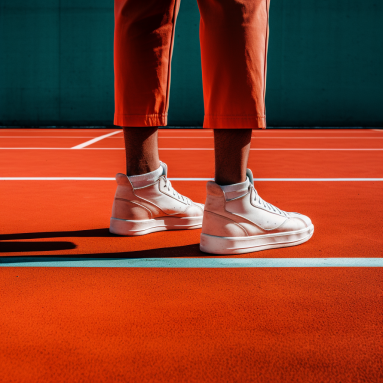Last Updated on November 20, 2025 by Drew Pierce
The strategic depth of pickleball, especially in doubles matches, is often underestimated. To excel, it’s not enough to only master your game; you must also be able to exploit your opponent’s weaknesses. Here are some pickleball doubles strategies to get the upper hand in your doubles pickleball matches.
Prefer to listen to this post? Play below:
1. Serve Receiver Cheating Forward
One common scenario is the serve receiver cheating forward, attempting to anticipate the serve and gain an advantage. This can be exploited by delivering deep serves that force them to retreat, disrupting their rhythm. Deep serves not only push the receiver back but also provide you and your partner time to establish yourselves at the non-volley zone line, giving you an advantage in the ensuing rally.

2. Changing the Tempo
Pickleball is a game of rhythm and pace. Often players get comfortable playing at a certain speed. Changing the tempo can disrupt their game, making it hard for them to predict and react to shots. Slow down the game with soft dinks, then surprise them with a quick, hard shot. This variation in speed can unsettle opponents, forcing them into errors or providing openings for decisive shots.
3. Exploiting Weak Backhands
Many players, especially beginners, have weaker backhand shots compared to their forehands. A core pickleball doubles strategy is to identify which player has a weak backhand and target it. Force them to play difficult backhand shots by directing the ball to their backhand side whenever possible. Keep in mind that this strategy requires careful aim and good control over the ball.
4. Using Lobs
Lobs, when used judiciously, can be a potent weapon. If your opponents are consistently positioned close to the net, a well-executed lob can force them back, breaking their formation. However, a poorly executed lob can be smashed back, so use this strategy sparingly and with precision. It’s most effective when your opponents least expect it, adding an element of surprise to your game.
5. Exploiting Poor Communication
In doubles pickleball, communication is key. Teams who communicate less or poorly can leave gaps in their defense. Pay attention to who takes the shot when the ball lands in the middle of the court. If it’s always the same player, target the other player to keep them out of rhythm. If there’s hesitation or confusion, aim for the middle to exploit their lack of coordination.

6. Attacking the Feet
Targeting the feet of the opponents can be an effective strategy. It is difficult to return low shots, and it often results in ‘popping up’ the ball, leaving an opportunity for a slam. This strategy works best against less agile opponents or those with slower reflexes.

7. Exploiting Fitness Levels
In long matches, fitness levels can be a deciding factor. If you notice your opponents getting tired, use strategies that make them move more. Wide-angle shots, deep serves, and lobs can force them to expend more energy, potentially leading to fatigue-induced errors.
8. Capitalizing on Overreliance on Power Shots
Some players rely heavily on power shots, often to the detriment of their game. While these shots can be intimidating, they are often less accurate and can be exploited by positioning yourself to counter them effectively. Encourage these shots by providing opportunities for your opponent to use them, then anticipate and return the shots accurately to catch them off guard.
9. Exploiting Limited Mobility
Players with limited mobility or slower footwork can be targeted with shots that force them to move across the court. This includes sideline-to-sideline shots, drop shots, and angled shots. The aim is to make them cover more ground, potentially leading to weaker returns.
10. Taking Advantage of Predictable Patterns
Many players, especially at the amateur level, tend to fall into patterns with their shots. Some might always serve to a particular spot; others might always return shots with a forehand. Once you’ve identified these patterns, you can anticipate their moves and plan your shots to exploit these habits.

Pickleball doubles strategies involve exploiting your opponent’s weaknesses, requiring careful observation, strategic thinking, and a varied set of shots. Remember, though, that pickleball is a game meant for enjoyment. While playing to win, it’s equally important to maintain sportsmanship and respect for your opponents. Incorporate these strategies into your game, and you’ll become a more formidable player and enhance your enjoyment of this wonderful sport.

2 thoughts on “Pickleball Doubles Strategies: How to Exploit Your Opponent’s Weaknesses”